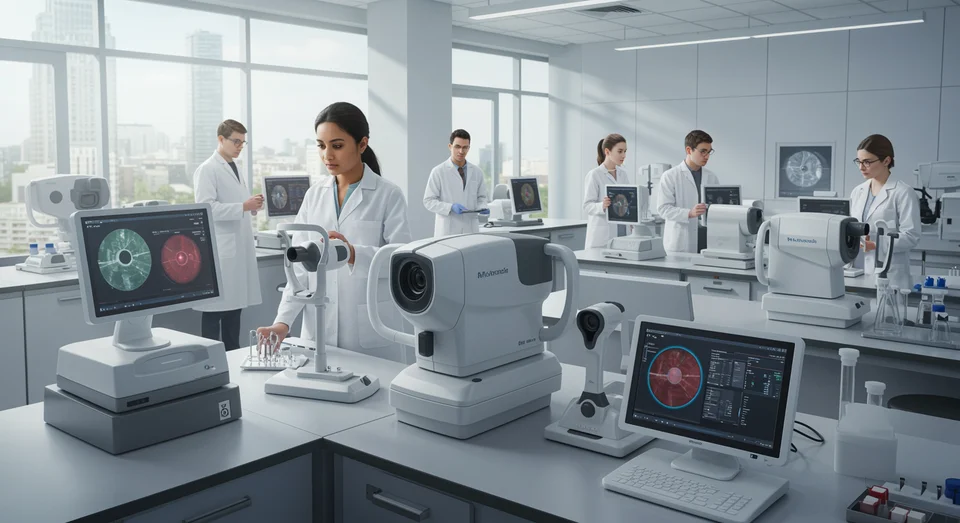Nonmydriatic Handheld Fundus Cameras Market to Hit $144.97M by 2030, Fueled by AI Innovations
334 views
The global Nonmydriatic Handheld Fundus Cameras Market, poised to leap from USD 103.24 million in 2024 to USD 144.97 million by 2030, is undergoing a transformative phase marked by technological evolution and strategic adaptation. These compact devices, indispensable for diagnosing eye conditions such as diabetic retinopathy and glaucoma, are increasingly woven into the fabric of clinical care and digital health ecosystems. As healthcare systems navigate the challenges of accessibility and efficiency, the market’s growth trajectory reflects a broader shift toward patient-centric solutions that prioritize precision, portability, and remote capabilities.

Revolutionizing Ophthalmic Diagnostics Through Technology
At the heart of this market’s expansion lies the relentless march of innovation. Advances in imaging technology have elevated the capabilities of nonmydriatic handheld fundus cameras, enabling high-definition visuals that rival traditional, bulkier models. The portability of these devices has allowed them to transcend the confines of specialized ophthalmic clinics, making them a staple in general practice settings and telemedicine platforms. This evolution has been particularly impactful in underserved regions, where the integration of minimally invasive diagnostic tools into remote monitoring systems has helped bridge the gap in eye care accessibility.
Telemedicine, a burgeoning frontier in healthcare, has found an ally in these devices. With their ability to deliver detailed retinal images remotely, nonmydriatic fundus cameras are empowering clinicians to extend their reach to rural and isolated populations. This trend not only addresses disparities in healthcare access but also aligns with the broader push toward digital health solutions that emphasize efficiency without compromising care quality.
Artificial intelligence has emerged as another cornerstone of this transformation. Diagnostic algorithms powered by AI are now capable of analyzing fundus images with remarkable accuracy, detecting early signs of ocular diseases and offering predictive insights. Coupled with advanced software integration, these innovations are reshaping workflows, reducing diagnostic errors, and enhancing patient outcomes. For instance, automated analysis tools can flag abnormalities in retinal scans, allowing healthcare providers to prioritize high-risk cases and allocate resources more effectively.
Regional Dynamics and Strategic Industry Movements
The global landscape of the Nonmydriatic Handheld Fundus Cameras Market reveals intriguing regional variations. Asia-Pacific, with its burgeoning healthcare infrastructure and rising expenditures, stands out as a hotbed of growth. Urban centers are adopting cutting-edge technologies, while rural areas benefit from portable solutions that cater to their logistical challenges. Governments and private entities alike are investing in expanding healthcare access, creating fertile ground for market players to introduce innovative products tailored to diverse needs.
Meanwhile, mature markets in the Americas and Europe continue to lead the charge in adopting advanced technologies. These regions boast sophisticated healthcare systems that prioritize precision and efficiency, driving demand for devices with AI-driven diagnostics and ergonomic designs. Manufacturers in these areas are increasingly focusing on modular designs that cater to the evolving demands of clinicians and patients alike. Additionally, regulatory frameworks in these regions are becoming more stringent, pushing companies to invest in compliance measures that ensure safety and efficacy.
Key players such as Optomed PLC, Baxter International Inc., Remidio Innovative Solutions Pvt. Ltd., and Volk Optical Inc. are spearheading advancements in this domain. Their substantial investments in research and development are yielding innovations that not only enhance imaging quality but also improve user experience. For instance, ergonomic designs are making these cameras more intuitive to handle, while AI-powered features are streamlining diagnostic processes. Strategic partnerships and collaborations further bolster their efforts, allowing them to diversify their product portfolios and tap into emerging markets.
A Patient-Centric Future for Ophthalmic Care
The trajectory of the Nonmydriatic Handheld Fundus Cameras Market underscores a broader shift in healthcare toward patient-centric solutions. These devices exemplify the convergence of technology and medicine, offering speed, accuracy, and accessibility that align with modern demands. As telehealth continues to gain traction, the role of portable diagnostic tools in remote monitoring and early intervention will only grow more significant.
Industry leaders are advised to focus on diversification and adaptability to maintain competitiveness in this dynamic market. Strengthening online sales channels is one such strategy, as digital platforms increasingly serve as primary avenues for product distribution. Compliance with emerging regulatory mandates is another critical consideration, ensuring that innovations meet the highest standards of safety and efficacy.
The emphasis on minimally invasive procedures, coupled with advancements in AI and software integration, paints a promising picture for the future of ophthalmic diagnostics. As healthcare systems worldwide strive to deliver more efficient and equitable care, the evolution of nonmydriatic handheld fundus cameras offers a compelling case study in how technology can transform patient outcomes and redefine industry standards.
In a world where vision is often taken for granted, these devices serve as a reminder of the profound impact that accessible, precise diagnostics can have on lives. With their ability to detect conditions early, guide timely interventions, and reach populations that have historically been left behind, they are not just tools of medicine—they are instruments of change. As the market grows and evolves, it carries with it the promise of a future where eye care is not a privilege but a universally accessible right.
